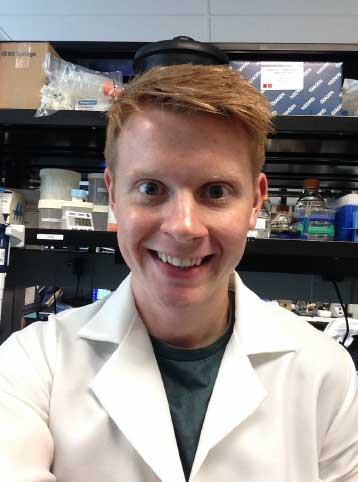Researchers from the University of California, San Francisco, and its affiliated Gladstone Institutes, are using a cutting-edge gene-editing tool known as CRISPR to identify mutations that make immune cells resistant to HIV.
 Dr. Judd HultquistThe team, which includes new Krim fellow Dr. Judd Hultquist, developed a high-throughput cell-editing platform using a variant of CRISPR/Cas9 technology to modify genes in immune cells to determine which ones successfully resisted HIV infection. High-throughput platforms enable researchers to use automated techniques to greatly increase the number of samples they can test.
Dr. Judd HultquistThe team, which includes new Krim fellow Dr. Judd Hultquist, developed a high-throughput cell-editing platform using a variant of CRISPR/Cas9 technology to modify genes in immune cells to determine which ones successfully resisted HIV infection. High-throughput platforms enable researchers to use automated techniques to greatly increase the number of samples they can test.
“It’s really exciting technology that opens up a wide array of pathways for exploration,” said Hultquist, one of the paper’s co-lead authors and a postdoctoral researcher at Gladstone Institutes. “We can identify new genes that are required for the virus to replicate and determine which genetic mutations make an individual resistant to HIV infection.”
While antiretroviral therapy (ART) can prevent HIV from multiplying, the drug cocktail cannot cure it. Once ART is stopped, the virus rebounds because of a viral reservoir that persists in the body. That reservoir is the main barrier to a cure.
However, a small number of people are resistant to HIV because of a naturally occurring mutation in the CCR5 gene. The mutation, called CCR5-delta32, prevents HIV from gaining access to the cell and causing infection. The “Berlin patient” was cured of his HIV infection following a stem-cell transplant from a donor with the CCR5-delta32 mutation. Other genes may play a role in HIV immunity as well.
“Most strategies, up until this point, have focused on targeting the virus itself, such as using CRISPR technology to target the integrated HIV genome,” said Hultquist. “Our approach is to target human genes the virus needs to survive instead.
“For example, we know some people are resistant to the virus despite repeated exposure. It’s often hard for us to determine which specific changes in our genes are responsible. This system gives us the ability to systematically test these mutations by engineering them into human blood cells and seeing if they confer resistance to infection.”
It’s really exciting technology that opens up a wide array of pathways for exploration. We can identify new genes that are required for the virus to replicate and determine which genetic mutations make an individual resistant to HIV infection.
The researchers mutated different genes in hundreds of thousands of T-cells from healthy volunteers. They then exposed the T-cells to HIV, checking to see which mutations effectively prevented infection.
For example, as proof of concept, they mutated the CXCR4 and CCR5 genes, two major co-receptors that allow HIV to infect immune cells. Inactivating either of these genes prevented the virus from entering T cells.
They then developed 146 different CRISPR-based edits, each designed to deactivate one of 45 genes that have been linked to HIV’s ability to integrate into host cells. They identified several genes whose absence conferred HIV resistance.
Hultquist said the team hopes to pinpoint more genes that are required for the virus to replicate, which may help in the development of new drugs. He said his findings could also assist with the development of cell-based therapy, whereby people with HIV receive cells from those who are resistant to the virus.
“This technology opens up so many doors for so many different researchers — not only those studying HIV, but also cancer, autoimmunity, and other infectious diseases,” he said. “This tool can be used to study any number of phenomena directly in human cells and should give us a powerful approach to curing a variety of human ailments.”
The research was published in the October 25, 2016, issue of the journal Cell Reports.
Read more here:
https://www.ucsf.edu/news/2016/10/404646/researchers-use-crispr-accelerate-search-hiv-cure